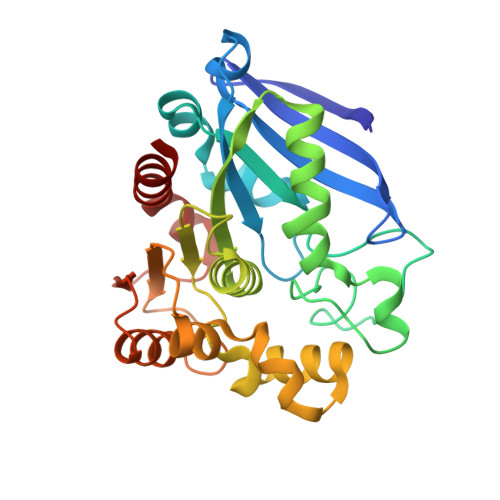Structural and functional characterization of a novel cold-active S-formylglutathione hydrolase (SfSFGH) homolog from Shewanella frigidimarina, a psychrophilic bacterium.
Lee, C.W., Yoo, W., Park, S.H., Le, L.T.H.L., Jeong, C.S., Ryu, B.H., Shin, S.C., Kim, H.W., Park, H., Kim, K.K., Kim, T.D., Lee, J.H.(2019) Microb Cell Fact 18: 140-140
- PubMed: 31426813
- DOI: https://doi.org/10.1186/s12934-019-1190-1
- Primary Citation of Related Structures:
6JZL - PubMed Abstract:
S-Formylglutathione is hydrolyzed to glutathione and formate by an S-formylglutathione hydrolase (SFGH) (3.1.2.12). This thiol esterase belongs to the esterase family and is also known as esterase D. SFGHs contain highly conserved active residues of Ser-Asp-His as a catalytic triad at the active site. Characterization and investigation of SFGH from Antarctic organisms at the molecular level is needed for industrial use through protein engineering. A novel cold-active S-formylglutathione hydrolase (SfSFGH) from Shewanella frigidimarina, composed of 279 amino acids with a molecular mass of ~ 31.0 kDa, was characterized. Sequence analysis of SfSFGH revealed a conserved pentapeptide of G-X-S-X-G found in various lipolytic enzymes along with a putative catalytic triad of Ser148-Asp224-His257. Activity analysis showed that SfSFGH was active towards short-chain esters, such as p-nitrophenyl acetate, butyrate, hexanoate, and octanoate. The optimum pH for enzymatic activity was slightly alkaline (pH 8.0). To investigate the active site configuration of SfSFGH, we determined the crystal structure of SfSFGH at 2.32 Å resolution. Structural analysis shows that a Trp182 residue is located at the active site entrance, allowing it to act as a gatekeeper residue to control substrate binding to SfSFGH. Moreover, SfSFGH displayed more than 50% of its initial activity in the presence of various chemicals, including 30% EtOH, 1% Triton X-100, 1% SDS, and 5 M urea. Mutation of Trp182 to Ala allowed SfSFGH to accommodate a longer chain of substrates. It is thought that the W182A mutation increases the substrate-binding pocket and decreases the steric effect for larger substrates in SfSFGH. Consequently, the W182A mutant has a broader substrate specificity compared to wild-type SfSFGH. Taken together, this study provides useful structure-function data of a SFGH family member and may inform protein engineering strategies for industrial applications of SfSFGH.
Organizational Affiliation:
Unit of Polar Genomics, Korea Polar Research Institute, Incheon, 21990, Republic of Korea.














